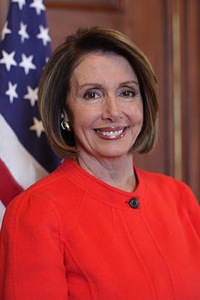
Members of the House of Representatives have offices in three buildings, each of which is named after a former speaker: Sam Rayburn, Nicholas Longworth and Joseph Gurney Cannon. When a fourth building is needed, I have little doubt it will be the “Nancy Pelosi House Office Building.” Not just because she was the first woman to be elected speaker, which was an historic achievement, but because Pelosi arguably accomplished more in her four year speakership than leaders who held the gavel much longer. If Speaker John Boehner wants to be remembered for more than obstructionism, he would be wise to look at how she did it.
Like Boehner, Pelosi started as a minority leader and had her caucus poised to take control in the mid-term election of an unpopular president. And, like Boehner, she spent her first two years as speaker with that opposing party president. That’s where the similarities end.
Pelosi came in with an agenda, and was never afraid to stand by it. When she couldn’t advance it through the Bush White House, she was a partner in government, allowing votes on funding the Iraq War and raising the debt ceiling. Those votes let members draw a contrast between Democrats and Republicans that was rewarded in 2008 with larger majorities and the White House.
When that opportunity came, she got things done. She did not get everything she wanted, but she always took half a loaf when she could. Obamacare wasn’t Pelosi’s ideal vision of health reform, but she knew insuring almost everyone was better than no one. She undoubtedly would have liked a stimulus with more infrastructure pending, but she guided the president’s package through the House. The same with Dodd-Frank financial reform. When Senate passage was unclear, Pelosi moved anyway. Climate change passed her House, as did the Dream Act and the repeal of Don’t Ask Don’t Tell. Those votes may well have cost her the majority, but she didn’t flinch – she was elected to get things done.

Contrast that to Speaker Boehner, whose leadership has suggested two goals: keep the majority for his party, and keep the gavel for himself. A real agenda? Not so much.
Sure, there were votes to repeal Obamacare and the Ryan budget, but they were largely symbolic nods to the Tea Party. There was never any chance those policies would pass the Senate, and there was no real effort to pass legislation that might. Boehner quickly preferred hostage negotiations to legislative ones, and put his caucus on the record for few things other than a willingness to have the federal government default on its debt.
Thus far, Boehner’s signature achievements are a few spending cuts, a pile of cans kicked to a rapidly approaching stretch of road, and a downgrade of the government’s bond rating. Hard to believe his party lost seats in 2012.
Were it not for gerrymandered districts, Boehner could easily have lost the House, as half a million more Americans voted for Democratic representatives than Republicans.
Boehner’s new willingness to suspend the debt ceiling for a few months suggests he may have learned something, but at present it is only a tactical shift. With President Obama ready to brand him as the barrier to poll tested initiatives like immigration and gun control, Boehner needs to develop an affirmative agenda he can push with Pelosi’s zeal. Even if it means negotiating. Even if it risks his majority. Gerrymandering may not save him again – some projections suggest that Democrats could retake the House if they won the popular vote by 8 percent. That’s the same amount they won by in 2006, which if Boehner isn’t careful, will be remembered as the beginning of Pelosi’s first tenure as speaker.











